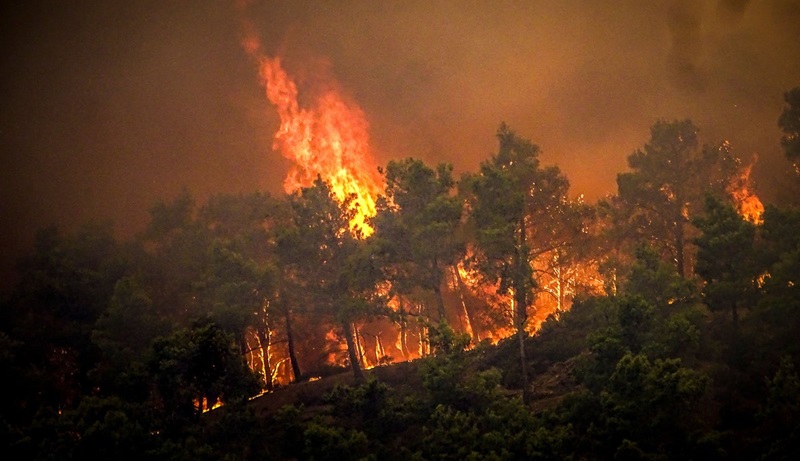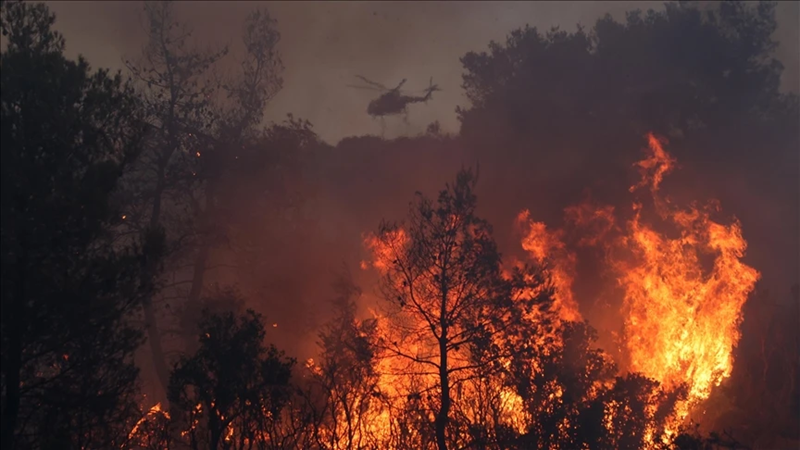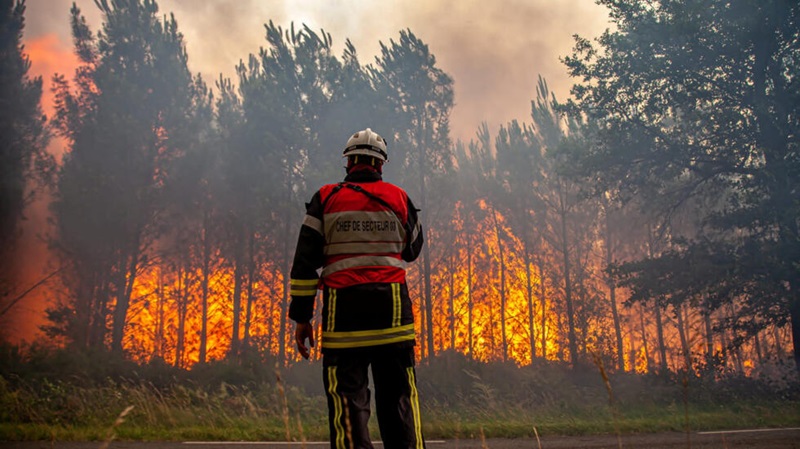Dangerous Summer Warning for Tourists Amid Ongoing Fires in Crete and Kos
Travelers planning to visit the idyllic Greek islands of Crete and Kos this summer are advised to exercise extreme caution due to the ongoing wildfires wreaking havoc in these regions. The raging infernos have caused significant destruction, prompting authorities to issue a grave warning to tourists about the potential hazards.
These unprecedented fires, fueled by high temperatures and strong winds, have scorched vast areas of vegetation, threatening wildlife and human settlements alike. Tourists are particularly urged to stay informed about the conflagration’s progress and to heed local advice and evacuation orders. The islands’ usually serene and picturesque landscapes have been transformed into dangerous fire zones, with smoke engulfing the sky and ash blanketing the ground. In addition to the immediate fire threat, potential respiratory issues due to the heavy smoke and compromised infrastructure pose serious risks to visitors.
The situation is continually evolving, and travelers should keep abreast of updates from local authorities and news outlets. While the people of Crete and Kos are no strangers to wildfires, the scale of these fires is unprecedented, making it a perilous time for tourism in these typically idyllic locales. Tour operators and airlines are also adjusting their plans in response to the situation and offering flexibility for those who had planned to visit the affected regions. It is crucial that everyone, including tourists, prioritize safety and take all necessary precautions during this challenging time.

Intensified Fire Risks in Popular Greek Destinations
The enchanting beauty of popular Greek destinations has been marred by the escalating issue of intensified fire risks in recent years. These fires, whether they are caused by climate-related factors or human activities, are posing a severe threat to the lush landscapes and idyllic environments of these places. The most iconic sites such as the islands of Mykonos or Santorini, renowned for their picturesque views and tranquil atmospheres, are now under the constant menace of potential fire outbreaks. The increasingly hotter and drier summers, a direct consequence of global warming, are creating the perfect conditions for wildfires to ignite and spread swiftly.
Human negligence, such as carelessly discarded cigarette butts or unattended campfires, are also significant contributors to these fires. The problem is further exacerbated by the dense vegetation present in many of these areas, which serves as fuel for the fires, enabling them to spread with alarming speed and intensity. These fires not only cause significant damage to the natural beauty of these destinations but also pose considerable risks to the lives and properties of local inhabitants and tourists alike.
The tourism industry, a vital source of income for the Greek economy, is also severely impacted by these fires. The images of scorched landscapes and news of fire outbreaks can deter potential visitors, leading to a decline in tourism revenue. This situation calls for robust strategies and measures to mitigate the fire risks and safeguard the pristine beauty of these popular Greek destinations.
Public awareness campaigns about the dangers and prevention of wildfires, strict enforcement of safety rules, and improved fire-fighting infrastructure can play a crucial role in minimizing the fire risks. Moreover, addressing the root cause of the problem, climate change, is imperative. Reducing greenhouse gas emissions and promoting sustainable practices can help in mitigating the impacts of global warming, thereby reducing the likelihood of such devastating fires.
Current Fire Conditions and Their Impact on Tourism
The ongoing wildfire incidents worldwide have significantly affected the tourism sector. In regions such as Australia, California, and the Amazon, which have been severely hit by these fire outbreaks, tourism has taken a considerable blow. These areas, previously recognized for their abundant natural beauty and wildlife, attracted countless tourists annually. However, the persisting fire conditions have resulted in a drastic reduction in tourist influx. The fear and risk associated with visiting these fire-prone areas have deterred many potential visitors. This decline in tourism not only affects the revenue generated from tourist activities but also impacts the local businesses reliant on tourists.
Moreover, the destruction of natural habitats, wildlife, and local attractions due to the fires further diminish the appeal of these destinations. The devastating impact on biodiversity is irreplaceable and can take years to recover, if at all. Consequently, the tourism industry is forced to reassess and adapt its operations and strategies in these regions. On another note, the smoke and poor air quality resulting from the fires also pose health risks, adding another layer of concern for potential visitors.
The media coverage of these fires globally has also played a role in influencing tourism. The alarming images and reports of the fire’s destruction can shape the public’s perception, further discouraging travel to these areas. However, this situation also underscores the importance of sustainable tourism practices, to mitigate the risk of such disasters in the future. While it is essential to revive tourism in these regions for economic recovery, it must be done responsibly, prioritizing the preservation and restoration of the environment. In conclusion, the current fire conditions worldwide have had a profound and potentially long-lasting impact on tourism, challenging the industry to innovate and adapt in the face of adversity.

Advice for Visitors: Safety Measures and Precautions
When visiting a new place, it is crucial to prioritize your safety by taking necessary measures and precautions. Being cautious starts with researching the destination thoroughly to familiarize yourself with the local customs, culture, and potential risks. This includes understanding the political stability, healthcare facilities, and common crimes in the area. Make sure to share your travel plans with someone trustworthy back home, including your accommodations and itinerary. Additionally, it’s wise to check for any travel advisories or warnings issued by your home country about the destination.
When it comes to personal safety, always keep your belongings secure and avoid displaying expensive items that could attract thieves. It’s recommended to use hotel safes for passport storage and only carry copies of important documents when exploring the area. Also, be aware of your surroundings, especially in crowded places where pickpocketing can occur. Avoid unfamiliar areas at night and always use reputable transport services.
In terms of health precautions, ensure your vaccinations are up-to-date based on the health risks of the destination. It’s also advisable to have a supply of any prescribed medications along with a doctor’s note explaining their necessity. Avoid consuming food and water from unreliable sources to protect against foodborne illnesses.
Lastly, respect the local culture and customs. Dress appropriately, especially when visiting religious or cultural sites. Be polite in your interactions with the locals, and refrain from actions that may cause offense.
In emergencies, knowledge of local emergency contact numbers can be a lifesaver, so keep them handy. Having suitable travel insurance coverage can also provide a solid safety net in case of unexpected situations like accidents or illness.
Remember, safety is paramount, and taking these measures and precautions can substantially enhance your overall travel experience.
Emergency Response and Relief Efforts in Affected Areas
Emergency response and relief efforts in affected areas are pivotal in times of natural disasters or other crisis situations. These efforts encompass a broad range of activities, from initial rescue operations to long-term recovery initiatives. The first stage typically involves immediate life-saving measures such as locating and rescuing individuals trapped under debris, providing medical assistance to the injured, or evacuating people from danger zones to safer locations. This is usually followed by the provision of basic necessities such as food, water, and shelter to those affected by the disaster.
Simultaneously, assessment teams work diligently to evaluate the extent of the damage and identify the most pressing needs of the community. Depending on the nature and scale of the disaster, these needs could range from healthcare and sanitation facilities to rebuilding homes and infrastructure. In the long-term, relief efforts shift towards rehabilitation and reconstruction, aiming to help affected communities return to normalcy. This could involve rebuilding schools, hospitals, and other crucial infrastructure, providing livelihood assistance, or offering trauma counseling and emotional support.
The success of emergency response and relief efforts often hinges on the efficiency and coordination among different stakeholders. These could include local and national government agencies, international organizations, non-profit groups, and even local community members. Technology also plays a key role in these efforts, with modern tools like drones, satellite imagery, and data analytics being used for effective planning and execution of response strategies.
However, emergency response and relief efforts are not without challenges. These can include logistical difficulties, resource constraints, and issues related to access and security in conflict-affected regions. Despite these hurdles, the importance of these efforts cannot be overstated. They not only save lives and alleviate suffering in the immediate aftermath of a disaster but also pave the way for the long-term recovery and resilience of affected communities.

Future Outlook: What Tourists Need to Know for the Rest of the Season
As we navigate through unprecedented times, tourists may find their travel plans shrouded in uncertainty. However, with careful planning and adherence to health guidelines, it is still possible to enjoy the remaining season. Before embarking on a journey, it is crucial to understand the ongoing pandemic situation in the intended destination. Some regions may have higher Covid-19 rates than others, and hence, can pose a greater risk.
Information about the safety protocols in place, including mask mandates, social distancing requirements, and quarantine rules, should be thoroughly researched. Tourists should also be aware of the operational status of tourist attractions, accommodations, and local eateries in the destination area. Many establishments may have altered their hours or services in response to the pandemic. It may also be beneficial to have a flexible itinerary. Unpredictable changes can occur, such as sudden closures or new travel advisories, and having a plan B can help mitigate potential disappointments.
Travel insurance has become more significant than ever, especially those that cover trip cancellations or medical emergencies due to Covid-19. Before purchasing any policy, travelers should ensure they fully understand the terms and conditions. Lastly, while physical health is paramount, mental wellbeing should not be overlooked. Traveling during a pandemic can be stressful, so it’s important to practice self-care and manage expectations. It’s a different landscape now, where safety takes precedence over leisure.
However, if tourists remain informed, flexible, and respectful of guidelines, they can still find joy in discovering new places. The key is to remember that we are all in this together, and every small action contributes to the global effort to overcome this crisis.
